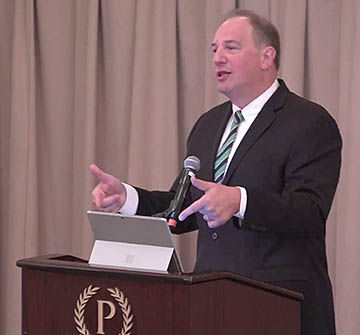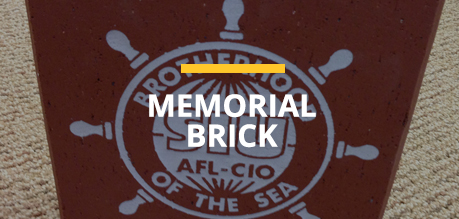‘Earning a Credential at Piney Point is Like Putting Money in the Bank’
When former U.S. Deputy Secretary of Labor Seth Harris received an invitation to deliver the keynote speech at a conference focused on identifying solid career paths, he quickly thought of the SIU.

Seth Harris addresses the conference
Harris, once an SIU field representative and now a Visiting Professor at the Cornell Institute for Public Affairs (as well as an attorney in the nation’s capital), spoke Nov. 8 to the Council for Adult and Experiential Learning (CAEL) in Chicago. CAEL is self-described as “a national nonprofit that works at all levels within the higher education, public and private sectors to make it easier for today’s students to get the education and training they need.”
“I share CAEL’s deep commitment to linking learning with work and helping working-class and middle-class Americans to acquire the skills they need to get and keep good jobs,” Harris told the audience. “I also agree with your work-based-learning agenda. As the Labor Department said in 2014, work-based learning is a proven strategy for adults of all ages, whether it’s registered apprenticeship, on-the-job training, work experience, internships, or job shadowing.”
Harris served four and one-half years as the Deputy U.S. Secretary of Labor and six months as Acting U.S. Secretary of Labor during the Obama administration. During his remarks in Chicago, he used (with permission) retired Recertified Bosun Ron Mena’s experience as an example of effective career training. (They first met in the 1980s, when Harris worked for the union.)
“Ron began his seafaring career in the late-1970s…. Ron’s parents sent him off to Piney Point, Maryland, to attend the Seafarers Harry Lundberg School of Seamanship,” Harris recalled, explaining how the union-affiliated school operates.
He then described the trainee program of that era, and recalled how Mena steadily progressed up the career ladder.
“When I met Ron, he had graduated from his apprenticeship and already returned to Piney Point several times to upgrade – that’s the SIU’s phrase for what people in the world of workforce development now call upskilling or reskilling,” Harris said. “So, Ron was a highly rated AB only a few years into his career.
“But what was remarkable about Ron was that he was a man with a plan,” he continued. “I remember Ron telling me in great detail how he was going to continue his career advancement. He knew that he could compete and win a particular job on board a particular ship. The job would last for six months. Ron had already identified the upgrading course he could take when he returned to Piney Point at the end of those six months. That course would allow him to earn a higher-level certification. Then, with his new credential in hand, Ron knew that he could ship out in a higher-skilled, better-paying job for another period of several months, and then return to Piney Point to earn another specialized credential.”
The plan worked. Mena retired from the SIU a year or so ago.
“He now lives a very nice life in Florida after a successful and lucrative career in a tough business,” Harris stated. “I’m not saying that Ron’s career was all ups and no downs. Very few of us follow a straight line to success. But Ron thrived in an industry in which the number of jobs has declined rather dramatically since he shipped out for the first time in 1978. Because of the opportunities provided to him by Piney Point and the SIU, he succeeded in climbing the ladder as the ladder got narrower and narrower.”
The bulk of Harris’s speech followed. He tackled what he called “the stackability conundrum.”
“I view Ron’s story as an excellent – almost paradigmatic – illustration of stackability,” Harris said. “The stackability idea is quite simple. It begins with a recognition that not every high school graduate should immediately rush off to college, and not every college leads you to a bachelor’s degree, and not every college graduate should proceed directly to graduate school, or perhaps attend graduate school at all.
“And while life is more difficult if you do it this way, some people can’t or just don’t graduate from high school,” he added. “All the data tell us that these folks, more than any others, need a pathway to credentials and degrees that will strengthen their ability to get good jobs at good wages. Stackability posits that there are career pathways leading to success that can begin with almost any credential that will help an adult to get a first job that produces an income. That income becomes the funding source for living expenses and, potentially, for additional training and credential attainment – a certificate, a registered apprenticeship, a license, a further degree.”
He then explained that research concludes “not enough workers have access to this key so they can use it to open the right doors…. Rates of upward income mobility in the United States have fallen sharply since the beginning of World War II.”
Harris expressed support for registered apprenticeship programs like the one in Piney Point, describing them as “a worthwhile investment for workers” when the training is likely to result in gainful employment.
“Ron Mena made that investment when he entered Piney Point’s cadet program, and it paid off,” Harris said. “Earning a credential at Piney Point is like putting money in the bank.”
He concluded with a series potential steps to bolster workforce training and employment – one of which is to recognize the value of union representation.
“Unions make a huge difference in education and training,” Harris said. “The story I told you about Ron Mena didn’t just happen to include a union and its training program. Ron’s story happened because of the union and its training program. And there are good reasons why the most stable and successful registered apprenticeship programs are the product of labor-management partnerships. Unions raise wages and guarantee benefits. Unions bargain with employers about investments in job training and career ladder development. Unions build job training programs that succeed because, if they don’t succeed, their members will elect new leaders.
“If job training is about upward mobility, then it is a core and necessary part of unions’ mission. Simply, if we had more unions and union members, we have would have more stories like Ron Mena’s.”
###





Comments are closed.